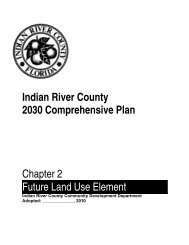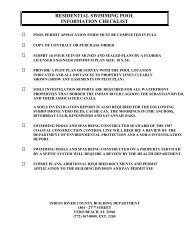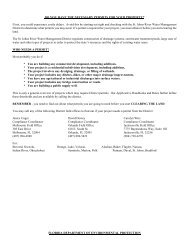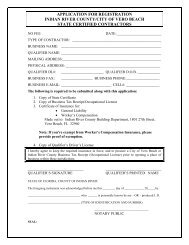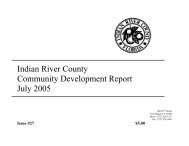Indian River County Impact Fee Study Final Report - irccdd.com
Indian River County Impact Fee Study Final Report - irccdd.com
Indian River County Impact Fee Study Final Report - irccdd.com
Create successful ePaper yourself
Turn your PDF publications into a flip-book with our unique Google optimized e-Paper software.
activities For other facilities such as emergency medical and rescue, it is difficult to<br />
allocate demand to land uses when many of the calls are related to crashes.<br />
The traditional method for estimating the current and future demand for certain facilities<br />
is to use the population as the basis. For example, some states have established a<br />
statewide minimum standard of 0.3 square feet of library space per capita based on the<br />
population of <strong>com</strong>munities meeting minimum thresholds. Yet, <strong>com</strong>munities with high<br />
volumes of nonresidents who use library services may need more than 0.3 square feet per<br />
resident to effectively meet this standard. In the case of police, fire, and emergency<br />
medical facilities, the higher the nonresident daytime population, the greater the need is<br />
for service relative to the resident population. Moreover, it is not enough to simply add<br />
resident population to the number of employees, since the service-demand characteristics<br />
of employees can vary considerably by type of industry. Using unweighted population<br />
and employment data to estimate facility needs may result in substantial error.<br />
For many facilities, there is a convenient way to rationally attribute demand by land use<br />
and to estimate aggregate demand for a <strong>com</strong>munity. This method is called "functional<br />
population." Functional population is the equivalent number of people occupying space<br />
within a <strong>com</strong>munity on a 24-hours-per-day, 7-days-per-week basis for public facilities<br />
providing around-the-clock services, such as police and fire/EMS services (or alternative<br />
time period such as an 11-hours-per-day, 5-days-per-week basis for public buildings,<br />
which are open on the average only a total of 55 hours per week).<br />
A person living and working in the <strong>com</strong>munity will have a functional population<br />
coefficient of 1.0. A person living in the <strong>com</strong>munity but working elsewhere may spend<br />
only 16 hours per day in the <strong>com</strong>munity on weekdays and 24 hours per day on weekends<br />
for a functional population coefficient of 0.76 (128-hour presence divided by 168 hours<br />
in one week). A person <strong>com</strong>muting into the <strong>com</strong>munity to work five days per week<br />
would have a functional population coefficient of 0.24 (40-hour presence divided by 168<br />
hours in one week). Similarly, a person traveling into the <strong>com</strong>munity to shop at stores,<br />
perhaps averaging 8 hours per week, would have a functional population coefficient of<br />
0.05.<br />
Functional population thus, is designed to capture the presence of all people within the<br />
<strong>com</strong>munity, whether residents, workers, or visitors, to arrive at a total estimate of<br />
effective population needing to be served. Functional population measures are important<br />
to gauge the demand for facilities serving the <strong>com</strong>munity 24 hours per day, 7 days per<br />
week for services such as police, fire, and emergency medical services, or 11 hours per<br />
day, 5 days per week for services such as public building services.<br />
This form of adjusting population to help measure real facility needs replaces the popular<br />
approach of merely weighting residents two-thirds and workers one-third (Nelson and<br />
Nicholas 1992). By estimating the functional population per unit of land use across all<br />
major land uses in a <strong>com</strong>munity, an estimate of the demand for certain facilities and<br />
services in the present and in a future year can be calculated. The following paragraphs<br />
explain how functional population is calculated.<br />
Tindale-Oliver & Associates, Inc.<br />
<strong>Indian</strong> <strong>River</strong> <strong>County</strong><br />
May 2005 II-7 <strong>Impact</strong> <strong>Fee</strong> <strong>Study</strong>



